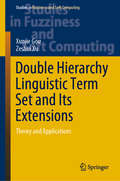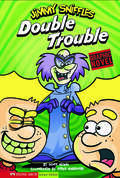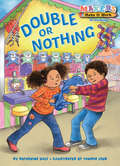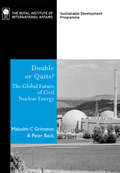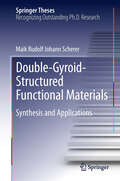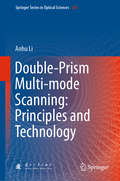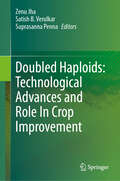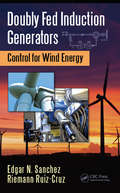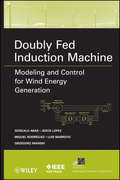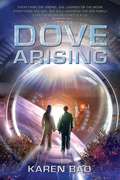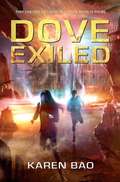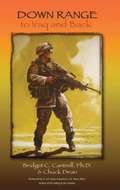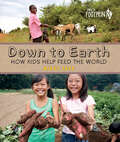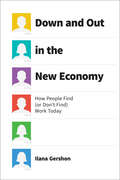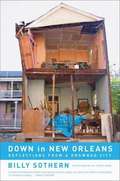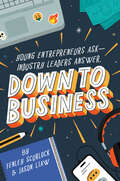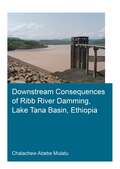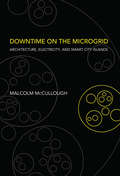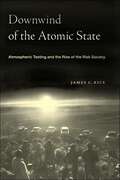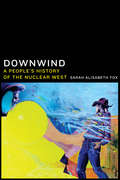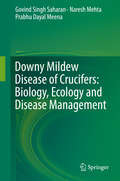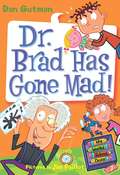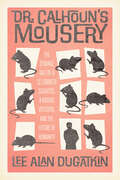- Table View
- List View
Double Hierarchy Linguistic Term Set and Its Extensions: Theory and Applications (Studies in Fuzziness and Soft Computing #396)
by Zeshui Xu Xunjie GouThis book presents the concept of the double hierarchy linguistic term set and its extensions, which can deal with dynamic and complex decision-making problems. With the rapid development of science and technology and the acceleration of information updating, the complexity of decision-making problems has become increasingly obvious. This book provides a comprehensive and systematic introduction to the latest research in the field, including measurement methods, consistency methods, group consensus and large-scale group consensus decision-making methods, as well as their practical applications. Intended for engineers, technicians, and researchers in the fields of computer linguistics, operations research, information science, management science and engineering, it also serves as a textbook for postgraduate and senior undergraduate university students.
Double Trouble (Jimmy Sniffles)
by Scott NickelJimmy Sniffles archenemy devises a plan to create an evil twin from Jimmy's nose hair. Written in graphic-novel format.
Double or Nothing: A Makers Story about 3D Printing (Makers Make It Work)
by Catherine DalyMason and Mia are twins . . . but don&’t always get along. When Mia wins a dolphin at the fair, Mason really, really wants one, too. If only Mia could make a twin dolphin! This story explores the Makers theme of 3D Printing and helps young makers understand how it works and get excited to try it for themselves! Mia and Mason are able to make a 3D scan of the dolphin to create a 3D model, and use a special kind of melted plastic to create the three-dimensional design. Tying into the popular Makers Movement, Makers Make It Work is a series of fun easy-to-read stories that focus on problem-solving and hands-on action. *Bonus Activity in the Book: Draw a picture of your favorite animal from each side—a 2D drawing, then use it to create a 3D model.
Double or Quits?: The Future of Civil Nuclear Energy
by Peter Beck Malcolm C. GrimstonGlobal energy demand is likely to rise substantially by the mid-21st century. At the same time, the use of fossil fuels may need to be severely curtailed to reduce the emission of greenhouse gases. Nuclear power is one of the few options that meet these conflicting requirements. However, its potential to do so is an issue of wide disagreement and high emotions, with balanced information hard to find. This text, the culmination of a two-year study, provides a dispassionate and objective assessment of the major disputes on the future role of this controversial fuel. Decisionmakers and their advisers, as well as proponents and opponents of the fuel, should find that this book provides clarification of the main issues influencing the future of nuclear energy: relative economics, public perceptions and the process of decisionmaking, nuclear research and development, waste management, reprocessing and proliferation, nuclear safety and nuclear power and the Kyoto Protocol. In the light of the many uncertainties in the field of energy, the relevance of these issues can only continue to grow.
Double-Gyroid-Structured Functional Materials: Synthesis and Applications
by Maik Rudolf SchererThe development of new high-tech applications and devices has created a seemingly insatiable demand for novel functional materials with enhanced and tailored properties. Such materials can be achieved by three-dimensional structuring on the nanoscale, giving rise to a significant enhancement of particular functional characteristics which stems from the ability to access both surface/interface and bulk properties. The highly ordered, bicontinuous double-gyroid morphology is a fascinating and particularly suitable 3D nanostructure for this purpose due to its highly accessible surface area, connectivity, narrow pore diameter distribution and superb structural stability. The presented study encompasses a wide range of modern nanotechnology techniques in a highly versatile bottom-up nanopatterning strategy that splits the fabrication process into two successive steps: the preparation of mesoporous double-gyroid templates utilizing diblock copolymer self-assembly, and their replication with a functional material employing electrochemical deposition and atomic layer deposition. The double-gyroid structured materials discussed include metals, metal oxides, and conjugated polymers, which are applied and characterized in high-performance devices, such as electrochromic displays, supercapacitors, chemical sensors and photovoltaics. This publication addresses a wide range of readers, from researchers and specialists who are professionally active in the field, to more general readers interested in chemistry, nanoscience and physics.
Double-Prism Multi-mode Scanning: Principles and Technology (Springer Series in Optical Sciences #216)
by Anhu LiThis book introduces double-prism multi-mode scanning theory and technology, focusing on double Risley-prism, multi-mode scanning models, methods and key techniques applied in multi-mode optical scanning and target tracking fields. It is first book to systematically and comprehensively describe basic multi-mode scanning theory and practical implementation techniques utilizing double Risley prisms. It includes rigorous modeling of double Risley-prism multi-mode scanning systems and high-efficiency solution algorithms for inverse problems with abundant illustrative examples and scanning error analyses, along with design guidance and performance test on specific scanning devices. Further, it presents the latest research results for forward scanning models and inverse tracking algorithms, sub-microradian fine scanning modeling with tilting double Risley prisms, nonlinear control strategy for double prism motion, calibration and experiment techniques for various double-prism layouts, as well as opto-mechanical system design and analysis. Featuring rigorous theoretical derivations illustrated with corresponding examples and original scanning apparatus, the book is a valuable reference resource for those developing and applying multi-mode scanning techniques in photoelectric scanning and tracking areas.
Doubled Haploids: Technological Advances and Role In Crop Improvement
by Suprasanna Penna Zenu Jha Satish B. VerulkarThis contributed volume covers the technology of double haploid production with special reference to anther culture and double haploid production in crop plants, and applications for basic and applied research in crop improvement. Globally, plant breeders aim to achieve higher crop productivity by using different breeding techniques. The double haploid genotypes have made this monotonous work easier and more efficient to a greater extent by achieving homozygosity and genetic fixation. Haploids are genotype with a gametophytic chromosome number, and a double haploid is a genotype developed when haploid cells undergo chromosome doubling. Artificial production of double haploids can easily shorten the time required to create homozygous plants which is vital in plant breeding. The book discusses how double haploids can help in accelerating conventional plant breeding programs and make early release of cultivars with superior and desirable traits along with greater utility in other research aspects of plant breeding, genetics, and genetic engineering. It also explains the role of double haploids in complementing back cross breeding by transferring genes of interest from wild relatives thus breaking genetic barriers. The book highlights the role of double haploids in genetic studies like inheritance of quantitative traits, quantitative trait loci (QTL) mapping, Genomics, gene identification, whole genome mapping and production of stable, transgenic plants. This book is essential for plant breeders, geneticists, researchers, and students in agricultural and crop sciences, offering insights into the transformative potential of double haploid technology in modern plant breeding.
Doubly Fed Induction Generators: Control for Wind Energy (Automation and Control Engineering)
by Edgar N. Sanchez Riemann Ruiz-CruzDoubly Fed Induction Generators: Control for Wind Energy provides a detailed source of information on the modeling and design of controllers for the doubly fed induction generator (DFIG) used in wind energy applications. Focusing on the use of nonlinear control techniques, this book: Discusses the main features and advantages of the DFIG Describes key theoretical fundamentals and the DFIG mathematical model Develops controllers using inverse optimal control, sliding modes, and neural networks Devises an improvement to add robustness in the presence of parametric variations Details the results of real-time implementations All controllers presented in the book are tested in a laboratory prototype. Comparisons between the controllers are made by analyzing statistical measures applied to the control objectives.
Doubly Fed Induction Machine
by Luis Marroyo Jesús López Gonzalo Abad Miguel Rodríguez Grzegorz IwanskiThis book will be focused on the modeling and control of the DFIM based wind turbines. In the first part of the book, the mathematical description of different basic dynamic models of the DFIM will be carried out. It will be accompanied by a detailed steady-state analysis of the machine. After that, a more sophisticated model of the machine that considers grid disturbances, such as voltage dips and unbalances will be also studied. The second part of the book surveys the most relevant control strategies used for the DFIM when it operates at the wind energy generation application. The control techniques studied, range from standard solutions used by wind turbine manufacturers, to the last developments oriented to improve the behavior of high power wind turbines, as well as control and hardware based solutions to address different faulty scenarios of the grid. In addition, the standalone DFIM generation system will be also analyzed.
Dove Arising
by Karen BaoPhaet Theta has lived her whole life in a colony on the Moon. She's barely spoken since her father died in an accident nine years ago. She cultivates the plants in Greenhouse 22, lets her best friend talk for her, and stays off the government's radar.Then her mother is arrested.The only way to save her younger siblings from the degrading Shelter is by enlisting in the Militia, the faceless army that polices the Lunar bases and protects them from attacks by desperate Earth-dwellers. Training is brutal, but it's where Phaet forms an uneasy but meaningful alliance with the preternaturally accomplished Wes, a fellow outsider.Rank high, save her siblings, free her mom: that's the plan. Until Phaet's logically ordered world begins to crumble...Suspenseful, intelligent, and hauntingly prescient, Dove Arising stands on the shoulders of our greatest tales of the future to tell a story that is all too relevant today.
Dove Arising
by Karen BaoPhaet Theta has lived her whole life in a colony on the Moon. She's barely spoken since her father died in an accident nine years ago. She cultivates the plants in Greenhouse 22, lets her best friend talk for her, and stays off the government's radar. <p><p> Then her mother is arrested. <p> The only way to save her younger siblings from the degrading Shelter is by enlisting in the Militia, the faceless army that polices the Lunar bases and protects them from attacks by desperate Earth-dwellers. Training is brutal, but it's where Phaet forms an uneasy but meaningful alliance with the preternaturally accomplished Wes, a fellow outsider. <p> Rank high, save her siblings, free her mom: that's the plan. Until Phaet's logically ordered world begins to crumble...Suspenseful, intelligent, and hauntingly prescient, Dove Arising stands on the shoulders of our greatest tales of the future to tell a story that is all too relevant today.
Dove Exiled
by Karen BaoPhaet Theta is a fugitive. Hiding in plain sight with her friend Wes's family on the drowned planet Earth, Phaet discovers the rugged beauty of the world her ancestors once called home. All her life, she's been taught to fear the "Earthbound," and their generosity and kindness surprise and touch Phaet. But when the Lunar Bases attack Wes's isolated village, Phaet's past catches up with her, and she's forced to choose: stay on Earth and fight beside the boy she's falling for, or stow away on a Moon-bound ship so she can save her brother and sister from the government that killed their mother. This thrilling sequel to Dove Arising plunges readers deeper into this complex and haunting world where freedom comes at a chilling price.From the Hardcover edition.
Down Milling Trimming Process Optimization for Carbon Fiber-Reinforced Plastic (SpringerBriefs in Applied Sciences and Technology)
by Saiful Bahri Mohamed Radzuwan Ab Rashid Martini Muhamad Jailani IsmailThis book offers recommendations on the milling processes for the carbon fiber reinforced plastic CFRP/Al2024. Due to the anisotropic and non-homogeneous structure of CFRP and the ductile nature of aluminum, the machining of this material is very challenging and causes various types of damage, such as matrix cracking and thermal alterations, fiber pullout and fuzzing during drilling and trimming, which affect the quality of machined surface. The book studies and models the machined surface quality of CFRP/Al2024 using a two-level full factorial design experiment. It describes the processes of trimming using down milling, and statistically and graphically analyzes the influence and interaction of cutting parameters. Lastly, the book presents the optimization of the cutting parameters in order to create a surface texture quality of CFRP/Al2024 to less than 1 µm.
Down Range: To Iraq and Back
by Bridget C. Cantrell Chuck Dean<p>As soldiers, we have spent countless years learning to survive the actual battle. Endless days on the firing range; countless hours in battle drills; months in combat learning the "ropes"; physical fitness training every day...all of these were dedicated to ensuring your survival and victory at the moment of truth. Now, it is time to dedicate some time to surviving when it is over. <p>PTSD is sometimes called "The gift that keeps on giving." If you die, that is not contagious--but if you live, and come out of the experience with a load of mental baggage, then your loved ones will most likely share in your struggles as well. <p>Reading this book ahead of time can be a form of inoculation, giving you insight that will help keep your combat reactions in perspective, and help you understand what is happening to your mind and body after wartime experiences. Just as we can equip ourselves to physically survive combat, we can also prepare to mentally survive the aftermath. This book is yet another tool in that equipping process.</p>
Down To Earth: How Kids Help Feed the World (Orca Footprints #1)
by Nikki TateKids all over the world help collect seeds, weed gardens, milk goats and herd ducks. From a balcony garden with pots of lettuce to a farm with hundreds of cows, kids can pitch in to bring the best and freshest products to their families' tables—and to market. Loaded with accessible information about the many facets of farming, Down to Earth takes a close look at everything from what an egg carton tells you to why genetic diversity matters—even to kids.
Down and Out in the New Economy: How People Find (or Don’t Find) Work Today
by Ilana GershonFinding a job used to be simple. You’d show up at an office and ask for an application. A friend would mention a job in their department. Or you’d see an ad in a newspaper and send in your cover letter. Maybe you’d call the company a week later to check in, but the basic approach was easy. And once you got a job, you would stay—often for decades. Now . . . well, it’s complicated. If you want to have a shot at a good job, you need to have a robust profile on LinkdIn. And an enticing personal brand. Or something like that—contemporary how-to books tend to offer contradictory advice. But they agree on one thing: in today’s economy, you can’t just be an employee looking to get hired—you have to market yourself as a business, one that can help another business achieve its goals. That’s a radical transformation in how we think about work and employment, says Ilana Gershon. And with Down and Out in the New Economy, she digs deep into that change and what it means, not just for job seekers, but for businesses and our very culture. In telling her story, Gershon covers all parts of the employment spectrum: she interviews hiring managers about how they assess candidates; attends personal branding seminars; talks with managers at companies around the United States to suss out regional differences—like how Silicon Valley firms look askance at the lengthier employment tenures of applicants from the Midwest. And she finds that not everything has changed: though the technological trappings may be glitzier, in a lot of cases, who you know remains more important than what you know. Throughout, Gershon keeps her eye on bigger questions, interested not in what lessons job-seekers can take—though there are plenty of those here—but on what it means to consider yourself a business. What does that blurring of personal and vocational lives do to our sense of our selves, the economy, our communities? Though it’s often dressed up in the language of liberation, is this approach actually disempowering workers at the expense of corporations? Rich in the voices of people deeply involved with all parts of the employment process, Down and Out in the New Economy offers a snapshot of the quest for work today—and a pointed analysis of its larger meaning.
Down in New Orleans: Reflections from a Drowned City
by Billy SothernBilly Sothern guides the reader on a journey through post-Katrina New Orleans and an array of indelible images--prisoners abandoned in their cells with waters rising, a longtime New Orleans resident of Middle Eastern descent unfairly imprisoned following the hurricane, trailer-bound New Orleanians struggling to make ends meet but celebrating with abandon during Mardi Gras--and offers a powerful vision of what Katrina has meant to New Orleans and what it still means to the nation at large.
Down to Business: 51 Industry Leaders Share Practical Advice on How to Become a Young Entrepreneur
by Fenley Scurlock Jason LiawYou have a start-up idea but ... where do you go from there? Two teen entrepreneurs bring together 51 influential business leaders for Q&As about starting a business, finding success, and, yes, making money.Fifteen-year-olds Fenley Scurlock and Jason Liaw had both started businesses by the time they'd reached middle school. In this groundbreaking book, these young entrepreneurs interview leaders involved with brand-name businesses like MasterClass, Hallmark, IKEA, Parachute, and more.They ask questions every burgeoning exec wants to know: How can I get started? Is college worth it? What skills do I need? How did YOU make it big?In a book that's unlike any book out there--for kid or adult entrepreneurs--Fenley and Jason give readers access to leading innovators, inventors, and executives as they tell their stories and provide tips to a new generation of bosses.
Downstream Consequences of Ribb River Damming, Lake Tana Basin, Ethiopia (IHE Delft PhD Thesis Series)
by Chalachew Abebe MulatuThis study assessed the downstream river system adaptation in response to upstream damming on the Ribb River, Ethiopia, to irrigate 15,000 ha. It combined primary and secondary data, and the application of remote sensing and mathematical modeling. The pre-dam morphodynamic trends of the Ribb River were analyzed for 59 years based on aerial photographs, satellite images, and newly collected field data. Three dam operation scenarios were developed to analyze the long-term hydro-morphological effects of the dam on the downstream river reaches. It also assessed the applicability of physics-based analytical equations (Equilibrium Theory) compared to a 1D numerical model (SOBEK-RE) to determine the least-morphologically impactful dam operation scenario on the river reaches downstream of the dam. Moreover, a HEC-RAS 2D hydrodynamic model was developed to assess the effect of the dam on the flooding extent of the Fogera Plain. This was used to study the potential implications of hydrological alteration on the ecology of the floodplain wetlands, as they are the habitats of important fish and bird species. The results contribute to knowledge on the hydro-morphological and environmental impacts of dams on downstream river systems. The developed methodologies and findings may be used to study future hydro-morphological and ecological changes that may arise due to other dam operations or climate change.
Downtime on the Microgrid: Architecture, Electricity, and Smart City Islands (Infrastructures)
by Malcolm McCulloughSomething good about the smart city: a human-centered account of why the future of electricity is local.Resilience now matters most, and most resilience is local—even for that most universal, foundational modern resource: the electric power grid. Today that technological marvel is changing more rapidly than it has for a lifetime, and in our new grid awareness, community microgrids have become a fascinating catalyst for cultural value change. In Downtime on the Microgrid, Malcolm McCullough offers a thoughtful counterpoint to the cascade of white papers on smart clean infrastructure. Writing from an experiential perspective, McCullough avoids the usual smart city futurism, technological solutionism, policy acronyms, green idealism, critical theory jargon, and doomsday prepping to provide new cultural context for a subject long a favorite theme in science and technology studies. McCullough describes the three eras of North American electrification: innovation, consolidation, and decentralization. He considers the microgrid boom and its relevance to the built environment as “architecture's grid edge.” Finally, he argues that resilience arises from clusters; although a microgrid is often described as an island, future resilience will require archipelagos—clusters of microgrids, with a two-way, intermittent connectiveness that is very different from the always-on, top-down technofuture we may be expecting. With Downtime on the Microgrid, McCullough rises above techno-hype to find something good about the smart city and reassuring about local resilience.
Downwind of the Atomic State: Atmospheric Testing and the Rise of the Risk Society
by James C. Rice2024 Outstanding Academic Title, given by Choice ReviewsHow the scientific community overlooked, ignored, and denied the catastrophic fallout of decades of nuclear testing in the American WestIn December of 1950, President Harry Truman gave authorization for the Atomic Energy Commission to conduct weapons tests and experiments on a section of a Nevada gunnery range. Over the next eleven years, more than a hundred detonations were conducted at the Nevada Test Site, and radioactive debris dispersed across the communities just downwind and through much of the country. In this important work, James C. Rice tells the hidden story of nuclear weapons testing and the negligence of the US government in protecting public health.Downwind of the Atomic State focuses on the key decisions and events shaping the Commission’s mismanagement of radiological contamination in the region, specifically on how the risks of fallout were defined and redefined, or, importantly, not defined at all, owing to organizational mistakes and the impetus to keep atomic testing going at all costs. Rice shows that although Atomic Energy Commission officials understood open-air detonations injected radioactive debris into the atmosphere, they did not understand, or seem to care, that the radioactivity would irrevocably contaminate these communities.The history of the atomic Southwest should be a wake-up call to everyone living in a world replete with large, complex organizations managing risky technological systems. The legacy of open-air detonations in Nevada pushes us to ask about the kinds of risks we are unwittingly living under today. What risks are we being exposed to by large organizations under the guise of security and science?
Downwind: A People's History of the Nuclear West
by Sarah Alisabeth FoxDownwind is an unflinching tale of the atomic West that reveals the intentional disregard for the inhabitants and the environment in nuclear testing by the federal government and in uranium extraction by mining corporations during and after the Cold War. Sarah Alisabeth Fox interviews residents of the Great Basin region effected by environmental contamination from the uranium industry and nuclear testing fallout. Those residents tell tales of communities ravaged by cancer epidemics, farmers and ranchers economically ruined by massive crop and animal deaths, and Native miners working in dangerous conditions without proper safety equipment so that the government could surreptitiously study the effects of radiation on humans. In chilling detail, Downwind brings to light the stories and concerns of these groups whose voices have been silenced and marginalized for decades in the name of “patriotism” and “national security.” With the renewed boom in mining in the American West, Fox’s look at this hidden history, unearthed from years of field interviews, archival research, and epidemiological studies, is a must-read for every American concerned about the fate of our western lands and communities.
Downy Mildew Disease of Crucifers: Biology, Ecology and Disease Management
by Govind Singh Saharan Naresh Mehta Prabhu Dayal MeenaThe book reviews key developments in downy mildew research, including the disease, its distribution, symptomatology, host range, yield losses, and disease assessment; the pathogen, its taxonomy, morphology, phylogeny, variability, sporulation, survival and perpetuation, spore germination, infection, pathogenesis, seed infection, disease cycle, epidemiology, forecasting, and fine structures. The book also elaborates the mechanisms of host resistance (biochemical, histological, genetic, and molecular, including cloning and the mapping of R-genes), disease resistance breeding strategies, and the genetics of host-parasite interactions. It explores disease management based on cultural, chemical, biological, host resistance, and integrated approaches; and provides suggestions for future research areas. This book offers a comprehensive guide to an economically important disease, reviewing in detail the extant body of literature. Divided into 16 chapters, each of which includes a wealth of photographs, graphs, histograms, tables, figures, flow charts, micrographs etc., it represents an invaluable source of information for all researchers, teachers, students, industrialists, farmers, policymakers, and all others who are interested in growing healthy and profitable cruciferous crops all over the world.
Dr. Brad Has Gone Mad! (My Weird School Daze #7)
by Dan Gutman Jim PaillotThe weirdness never stops! Ella Mentry School's counselor wants everybody to stop arguing and get along with one another. He wants everybody to be polite! He wants everybody to live in peace and harmony! What is his problem? Now the boys have to play with dolls! The girls have to play with action figures! And that's only the start of Dr. Brad's weird methods. . . .
Dr. Calhoun's Mousery: The Strange Tale of a Celebrated Scientist, a Rodent Dystopia, and the Future of Humanity
by Lee Alan Dugatkin“Brilliant. . . . An absorbing read and a potent lesson in moral behavior—both of rodents and of humans.”—Deborah Blum, Pulitzer Prize–winning author of The Poison Squad • “A fascinating read about an immensely influential scientist.”—Robert M. Sapolsky, author of the New York Times–bestseller Determined • “Stimulating scientific history. . . . Colorful accounts. . . . This fascinates.”—Publishers Weekly A bizarre and compelling biography of a scientist and his work, using rodent cities to question the potential catastrophes of human overpopulation. It was the strangest of experiments. What began as a utopian environment, where mice had sumptuous accommodations, had all the food and water they could want, and were free from disease and predators, turned into a mouse hell. Science writer and animal behaviorist Lee Alan Dugatkin introduces readers to the peculiar work of rodent researcher John Bumpass Calhoun. In this enthralling tale, Dugatkin shows how an ecologist-turned-psychologist-turned-futurist became a science rock star embedded in the culture of the 1960s and 1970s. As interest grew in his rodent cities, Calhoun was courted by city planners and his work was reflected in everything from Tom Wolfe’s hard-hitting writing to the children’s book Mrs. Frisby and the Rats of NIMH. He was invited to meetings with the Royal Society and the pope and taken seriously when he proposed a worldwide cybernetic brain—a decade before others made the internet a reality. Readers see how Calhoun’s experiments—rodent apartment complexes like “Mouse Universe 25”—led to his concept of “behavioral sinks” with real effects on public policy discussions. Overpopulation in Calhoun’s mouse (and rat) complexes led to the loss of sex drive, the absence of maternal care, and a class of automatons that included “the beautiful ones,” who spent their time grooming themselves while shunning socialization. Calhoun—and those who followed his work—saw the collapse of this mouse population as a harbinger of the ill effects of an overpopulated human world. Drawing on previously unpublished archival research and interviews with Calhoun’s family and former colleagues, Dugatkin offers a riveting account of an intriguing scientific figure. Considering Dr. Calhoun’s experiments, he explores the changing nature of scientific research and delves into what the study of animal behavior can teach us about ourselves.
